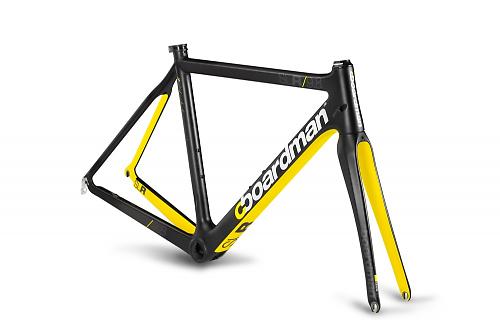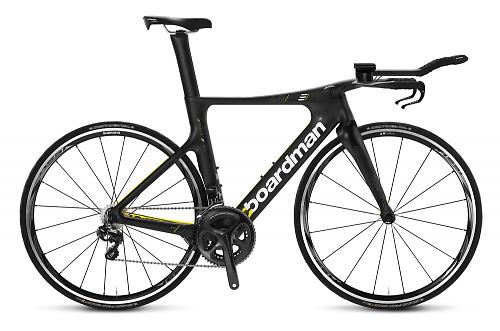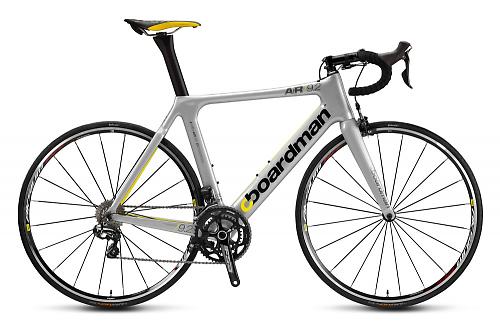- News
- Reviews
- Bikes
- Accessories
- Accessories - misc
- Computer mounts
- Bags
- Bar ends
- Bike bags & cases
- Bottle cages
- Bottles
- Cameras
- Car racks
- Child seats
- Computers
- Glasses
- GPS units
- Helmets
- Lights - front
- Lights - rear
- Lights - sets
- Locks
- Mirrors
- Mudguards
- Racks
- Pumps & CO2 inflators
- Puncture kits
- Reflectives
- Smart watches
- Stands and racks
- Trailers
- Clothing
- Components
- Bar tape & grips
- Bottom brackets
- Brake & gear cables
- Brake & STI levers
- Brake pads & spares
- Brakes
- Cassettes & freewheels
- Chains
- Chainsets & chainrings
- Derailleurs - front
- Derailleurs - rear
- Forks
- Gear levers & shifters
- Groupsets
- Handlebars & extensions
- Headsets
- Hubs
- Inner tubes
- Pedals
- Quick releases & skewers
- Saddles
- Seatposts
- Stems
- Wheels
- Tyres
- Health, fitness and nutrition
- Tools and workshop
- Miscellaneous
- Tubeless valves
- Buyers Guides
- Features
- Forum
- Recommends
- Podcast
 Chris Boardman interview
Chris Boardman interview10 minute interview: Chris Boardman
Last week saw the launch of Boardman Bikes’ new Elite range and we caught up with Chris Boardman himself to find out where he thinks bike design, and the Boardman range in particular, is heading next. He also gave us an insight into what how he thinks the UCI tech rules should be brought up to date…
road.cc: The new Elite range looks exciting and it seems like it covers a lot of ground. Is there a bike that stands out as your favourite?
Chris Boardman: That’s hard. I suppose it has got to be… Well, it’s a bit like saying which is your favourite kid! We’ve certainly put a lot into the time trial bike [the AiR/TTE].
 The whole company has gone through a learning process with this range. We’ve been working on it for two years, fighting to get to the launch. I’ve done a lot of stuff with the British Cycling team where we had to deliver on a particular day, and we delivered 1,793 pieces of equipment on time, so I know what it’s like.
The whole company has gone through a learning process with this range. We’ve been working on it for two years, fighting to get to the launch. I’ve done a lot of stuff with the British Cycling team where we had to deliver on a particular day, and we delivered 1,793 pieces of equipment on time, so I know what it’s like.
You always try to cram in as much as you possibly can, although that makes it difficult. It’s quite a relief now to actually launch it. We hope that people are going to like it – that’s the whole point of a commercial enterprise – but ultimately, that’s all you can do.

I actually learned this at the Olympic Games in 1992. I know it sounds daft but I can remember sitting on the start line thinking, “I’ve just got to be as good as I can be”, and to cross the line and see where it got me. At the time I was an unemployed carpenter with no money and 62 million people watching. It’s quite a liberating point of view. A psychologist called John Syer got me to realise that all you can do, ultimately, is the best that you can.
It seems like integration has become a big focus now, not just in the time trial world but in road bikes too…
Yes, integration is the future, more and more so. It helps aerodynamically – a bit – and it looks nice, so there’s a lot of incentive to integrate.

The challenge with integration, even though it looks beautiful, is that it gets incredibly expensive. So if you want to do a road bike, you’ve got to do all the handlebars and stems… how many different iterations would you have to do to make it work? That’s the challenge and that’s what we’re working on.

It’s logical to take things to the next step, putting brakes inside on a road bike – brakes that work well – putting seatpost clamps inside, our single bolt, four position seat post clamp… The next step is to work on the handlebars and stem, and we’re already doing that.
So development of the range is a continuous process?
It is, yes. It’s quite hard to let something go when you didn’t quite get one aspect ready, but you have to.

I think with all developments, what the punter needs to do is demand evidence of the benefits – preferably independent evidence –because there are so many claims, so much noise from people saying that this is faster, or that is faster.
So we’re going to see more integration, but what else are we going to see next in bike design?
Because of the UCI regulations, in the last 12-24 months people have gone, “You know, we could just make something for triathletes because we’re sick of these constraints and we don’t need them.” So that trend could continue unless the UCI rules change.
Will the Boardman brand go down this route?
I’d be fascinated to do it because I’d like to have the gloves off! We haven’t certified this bike [the AiR/TTE] with the UCI but I think it will be okay.

And if you’re thinking about chucking out the rulebook on the time trial/triathlon side of things, what about doing the same with road bikes?
Yeah, but the problem there is that you’re also going up against history. Cycling is a very, very historic sport. People have a perception of what a road bike should look like. You might not realise it, but there’s an influence in your head, so if you do something too different, people will react against it.
Where do you see the Boardman Elite range being in three years, say, or even five years?
I think you’d have to ask me in a year or so. Carbon fibre still has a great future. People are starting to mess around with titanium and aluminium again but I think that’s just a trend – trying to find a new thing to do. Carbon fibre isn’t going to go out of fashion any time soon. Weight-wise you can go a lot lower if you decide to throw out 6.8kg as a constraint.

So that takes us on to the UCI tech regs…
I was asked to head up their commission two weeks ago, but I had to turn it down. I thought about it but to do it properly I’d need to not do other things, and conflicts of interest would get to the point where it would be untenable, but I’m having an input.
I’ll be interested to see which way they go. I think it’s possible that the regulations could change – not to have more regulations but to start stripping some out. That doesn’t mean that everything goes, but it’s so overcomplicated. There’s loads that could be done.
Okay, so with a new president just elected at the UCI, now seems the perfect time for change. What should be done?
It’s happening. I think we need to review the Lugano Charter [see below] based on the primacy of man over machine – but that’s as clear as mud.
What does that mean? You need to allow progression but at a level where the the costs and availability make it accessible to everyone, and then it’s fair.
So 6.8kg: that needs reviewing now. We know we can make a totally solid, safe bike well below that now, so let’s start to let things move forward. Let it move and let the industry flourish and grow. People want interesting new stuff.

To be fair, the UCI have started to make changes. They’ve said that we’re not going to bother with fairings or no fairings, we’re just going to say, "Here’s the box, it [the relevant frame section] has to fit in the box," and suddenly it’s simplified. So there’s lots of stuff that could be stripped out and that’s the way to go.
The main one isn’t the rules. The rules have been good for about 10 years. The problem has been the application of the rules. The focus is not the regulations but the commissaires and that’s where I’d put my effort – to get consistent application of the rules.
Note: The UCI’s Lugano Charter of 1996 stated, “The UCI wishes to recall that the real meaning of cycle sport is to bring riders together to compete on an equal footing and thereby decide which of them is physically the best.”
It said that technological advances meant that, “The performance achieved depends more on the form of the man-machine ensemble than the physical qualities of the rider, and this goes against the very meaning of cycle sport.”
Essentially, the Lugano Charter led to bicycle equipment rules and regulations that were implemented in 2000, the best known of which is the minimum bicycle weight limit of 6.8kg for UCI-sanctioned road events.
Mat has been in cycling media since 1996, on titles including BikeRadar, Total Bike, Total Mountain Bike, What Mountain Bike and Mountain Biking UK, and he has been editor of 220 Triathlon and Cycling Plus. Mat has been road.cc technical editor for over a decade, testing bikes, fettling the latest kit, and trying out the most up-to-the-minute clothing. He has won his category in Ironman UK 70.3 and finished on the podium in both marathons he has run. Mat is a Cambridge graduate who did a post-grad in magazine journalism, and he is a winner of the Cycling Media Award for Specialist Online Writer. Now over 50, he's riding road and gravel bikes most days for fun and fitness rather than training for competitions.
Latest Comments
- Smoggysteve 40 min 59 sec ago
There is a theory that the majority of crashes in the pro peloton are due to disc brakes. The theory being that because they are better at stopping...
- ooblyboo 43 min 11 sec ago
Doubling down on a video that was in such incredibly poor taste and lacking in any tangible evidence was simply astonishing. Regardless of whether...
- Slartibartfast 43 min 23 sec ago
Just a heads up - the term 'Aspergers' isn't really ok these days due to its links to a nazi scientist. It certainly isn't used by professionals...
- ktache 1 hour 44 min ago
DCI Mark, neck height is worse...
- Anonymousattorney 1 hour 45 min ago
Thankfully the video seems now to have been taken down.
- kingleo 1 hour 56 min ago
One of the things that causes a lot of crashes is the managers telling the riders to 'get to the front, get to the front, get to the front'.
- don simon fbpe 3 hours 44 min ago
Aren't immigrants supposed to respect the law of the land that they settle in?
- Rendel Harris 4 hours 1 min ago
The publicity for the fine is more free advertising, no? It says look at us, not only are we so cool film stars use us, we're so socially...
- Rendel Harris 4 hours 34 min ago
It doesn't, look at the boycott of Israel, for example, a country with the closest possible ties with the USA. Back in the day, the boycott of...
- muhasib 5 hours 20 min ago
Nice of them to put an internal storage space behind the head tube, should be able to get a few gels in there!
Add new comment
11 comments
Ham-planet, the fuss over weight limits is because the manufacturers have produced good, reliable equipment which needs lumps of lead or cast iron adding to them so that teams meet the UCI weight limit. Surely removing this random lump of ballast has got to be a good thing, think how much better a bike is going to feel, brake, corner and accelerate if you could remove a kilo or so of scrap metal.
???
I don't understand all the fuss over the weight limit. How many of you out there have bikes you can't race because they're too light, or would buy a lighter one tomorrow if the limit was lowered? The weight limit provoked manufacturers to find different ways to differentiate their products. I doubt we'd be seeing so much aero development (for better or worse) if they were still in an arms race towards the weightless bike. I reckon it's had a positive effect on sportive/endurance bikes too: it's easier to sell a comfy bike that's 'just 500 g heavier than the full-on race model', than a comfy bike that's whole kilograms behind.
CB, CH are not inventors. They speak as if they were.
Integration has been there all along, for decades. Philosophies come and go. If Integration is all the rage now, consider the other extreme of mass proliferation of in particular Bottom Bracket standards which has been seen in recent times. Just saying.
Glorify revolutions all you want, a bike still remains a bike. CB is still a reasonably respectable.
There's so much that could be discussed but all most people are interested in is the 6.8 kg minimum weight rule. The only ones to benefit from that are manufacturers ("stiffer, lighter, better and betterer, but it now!") and overweight MAMILs with money to burn.
The only ones to benefit from that are manufacturers ("stiffer, lighter, better and betterer, but it now!") and overweight MAMILs with money to burn.
Much more useful. I'm sure Chris is in a great position to have some useful input - he has been a rider who has seen his track position and bikes banned and in his post-retirement involvement also has ideas both for governance and product development.
Not only can you make a safe bike below 6.8 Kg, but surely it's possible to make a safe bike for, say, Emma Pooley (48 Kg) at a lower weight than it's safe to make a bike for, say, Marcel Kittel (86 Kg).
And if you don't then the lighter rider has to heave about a higher proportion of body-mass, so that's an unfair artefact created by the rules.
Similarly, there will be riders whose personal dimensions are physiologically better suited to UCI size/geometry limits than others, so in that case it's not just about the athletes, but partly how well the athletes conform to UCI's baroque regulations, so that's an unfair artefact created by the rules.
Sailing has both development classes and one-design classes. So you get innovation and you also get pure athlete to athlete competition. It's not one or the other, you can have both.
So here's to some intelligent changes!
There was a good reason for the weight limit, and the main one was that the bike remained safe for whomever rode it. I think that weight limit could be knocked down to something lower (4.5kg possibly), but the weight restriction should be the same for each rider - perhaps with slight variation for the size (60cm frames being heavier than 50cm etc). If you turn it into F1 with whatever changes you like I think a) you'll have a lot of unnecessary/ineffectual changes by manufacturers for marketing purposes b) you'll have incessant tinkering until riders bikes do disintegrate underneath them and c) it becomes about things other than the competition……
In your case above, there is an inherent difference between the riders anyway - why should Pooley get a weight advantage when she is already a lighter build…..I think what makes sports interesting is that, all things being equal, you pit your body against someone else's, and so making it an uneven playing field makes it about other things…..so I am for a change in the rules, but I'm not for bike doping.
If I want to see what is the fastest combination of man & machine on two-wheels, I tune into MotoGP.
I, at least, would find it a huge turn-off if cycling became in part a battle of who had the best technology.
The Lugano is pretty clear to me. Man not machine. That said the rules can be reviewed. Boardman clearly loves what he does and his passion for the sport is infectious. Great guy.
Its seems to me that for cycling not to embrace innovations in both bike design and materials would be a lost opportunity for the sport. Thumbs up to Chris and his excellent quality bikes.
"The rules have been good for about 10 years. The problem has been the application of the rules."
Innovation has been embraced, but within guidelines — just like in F1 racing. Comparing bikes of today with those of fifteen years ago and suggesting that innovation is not allowed is thoughtless. Besides, what is wrong with keeping the design and manufacture of bikes used in competition within a set of parameters? What sport in the world does not regulate its equipment?
The UCI has not been without problems but sometimes this repetition of mindless anti-establishment propaganda is very tiring — the "not allowing innovation" line has been repeated ad nauseum for years, despite all the evidence to the contrary.